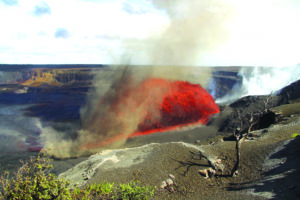Kilauea shoots lava for 31st time since December
HONOLULU, Aug 23: Hawaii’s Kilauea volcano erupted again on Friday, marking its 31st eruption since December. Lava fountains reached up to 30 meters, shooting across the summit crater floor in Halemaʻumaʻu Crater, located within Hawaii Volcanoes National Park.
The eruption poses no threat to homes and remains confined to the summit, though it offers an awe-inspiring sight to onlookers and online viewers via US Geological Survey livestreams.
Scientists explain the eruption as part of a continuous sequence that began in December.
Magma rises from deep underground into a lower chamber, then moves to an upper chamber and erupts through narrow vents, similar to releasing pressure from a shaken bottle.
Previous similar eruption patterns were recorded in 1959, 1969, and 1983, with the 1983 event lasting over three decades.
The current lava fountains are shorter than earlier ones, possibly due to widening vents that reduce pressure, but geologists expect the displays to remain visually impressive.
While sensors can sometimes predict eruptions days in advance, scientists say the long-term future of this eruption is uncertain—it could stop or evolve into a prolonged lava flow like past events.
For Native Hawaiians, the eruption holds deep cultural meaning. Halemaʻumaʻu Crater is believed to be the home of the volcano goddess Pele.
Huihui Kanahele-Mossman of the Edith Kanakaʻole Foundation visits the site to perform traditional chants and offerings, linking the eruption to centuries-old Hawaiian stories and hula traditions.
Tourism has surged, with park visitation rising every month in 2025; April saw a 49% increase compared to the same time in 2024.
Park officials urge visitors to stay on marked trails due to dangers like unstable cliffs, cracks, volcanic gases, and ash. Nighttime visitors are advised to carry flashlights and keep children close.
While the eruption’s future remains uncertain, both scientists and cultural practitioners continue to observe and honor Kilauea’s powerful display—part natural wonder, part living tradition, and a reminder of the island’s ever-changing volcanic landscape. (AP)




